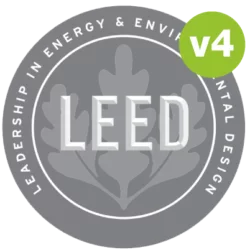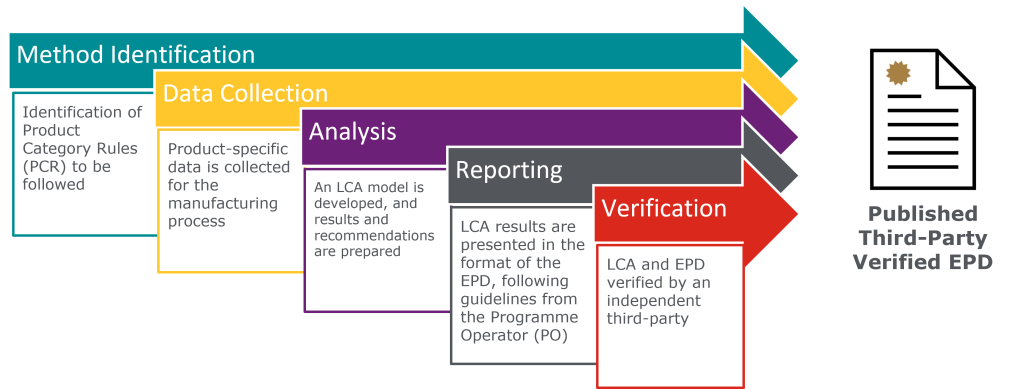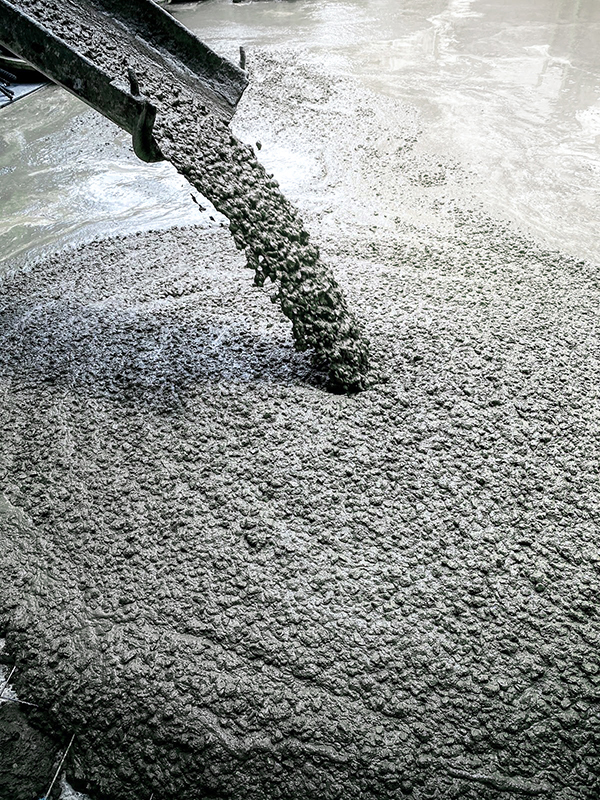
Introduction: The Future of Sustainable Construction
Imagine a future where every construction decision helps build a more sustainable world. This vision is becoming increasingly attainable through the strategic use of Environmental Product Declarations (EPDs). These declarations provide a transparent and standardised method to assess the environmental impact of construction materials. However, like any tool, the value of EPDs hinges on their proper usage.
The Importance of EPDs in the Construction Industry
The construction industry is responsible for a significant portion of global carbon dioxide (CO2) emissions, contributing to about 37% of global operational and process-related emissions in 2021.1 Within the UAE, this industry contributed to approximately 27% of total greenhouse gas emissions in 2019 and is thus a key sector for the implementation of decarbonisation efforts to meet 2030 targets.2 Process-related emissions are associated with the manufacturing process for building materials, such as concrete or steel, including the extraction of raw materials and production processes, which account for approximately 9% of the 37% of global emissions, and can be quantified using Life Cycle Assessment (LCA).1

LCA is the compilation and evaluation of the inputs, outputs, and the potential environmental impacts of a product system throughout its life cycle.3 A variety of environmental impact categories can be assessed with LCA, including climate change, acidification, eutrophication, photochemical ozone formation, and resource depletion (metals/minerals). For a holistic assessment, multiple impact categories should be evaluated to avoid burden-shifting from one impact category to another. Within the Buildings and Construction industry, EPDs are commonly used to communicate product LCA results, and there is a growing demand for more published EPDs. AESG, through its active involvement in decarbonisation projects within the GCC region, is spearheading initiatives to mitigate the industry’s contribution to emissions.

Leveraging EPDs for Sustainable Decisions
The release of LEED v4 has spurred an increase in EPDs published for construction, along with more Programme Operators (POs) and developed Product Category Rules (PCRs) and complementary PCRs (c-PCRs). POs oversee EPD verification and publication, and may also create PCRs and c-PCRs. International rating systems like LEED have been utilised in the UAE since 2006, with around 386 certified projects as of mid-2020 and growing steadily.11
EPDs provide detailed, third-party verified information about the environmental impact of products. This data empowers decision-makers to choose materials that align with their sustainability goals. However, to fully leverage the potential of EPDs in sustainable construction, it’s crucial to understand and address the challenges they present.

CASE STUDY
Addressing Comparability Challenges in EPDs
A significant challenge lies in ensuring comparability among EPDs within rating systems. EPDs introduce uncertainties stemming from varying methodologies employed in their creation, influencing the accuracy of environmental impact assessments. These uncertainties arise from factors such as data collection methods, system boundaries, and allocation procedures, making it challenging to precisely quantify a product’s environmental footprint. Variations in methods used can hinder accurate comparisons, potentially leading to the selection of products that does not necessarily have a reduced impact. Ensuring that EPDs are consistent and comparable across different materials and regions is essential for making informed decisions.
To assess compatibility, we collected EPDs from steel and concrete manufacturers in the GCC region. Initially, over 70 EPDs for concrete and 8 EPDs for reinforcement steel were mainly found in UAE and Saudi Arabia. Duplicate concrete datasets were removed, focusing on ready-mix concrete of similar grade. The aim was to assess comparability between EPDs for similar products, following a methodology developed and refined in recent studies.6 Factors such as PCR followed, functional unit, system boundary, allocation method and data quality (specific versus generic) were critically examined, recognising that variations in data sources, methodologies and boundary conditions may impact comparability.

Variability in Concrete EPDs
For the ready-mix concrete EPDs, the results we found varied. In this case, multiple POs were used for the verification and publication of the EPDs. This led to the following observations:
Because of this, it is recommended that the EPDs for concrete are thoroughly examined for their comparability before decisions are made based solely on the reported EPD results.
Caution in Steel EPDs Comparison
We found that for reinforcement steel within the region, EPDs were published from the same PO and largely applied the same methodological assumptions. The variation in these datasets was mainly the following:
• The Product Category Rules (PCRs)
• Underlying standards
The main reason for this was found to be the transition from standard EN 15804:A1 to EN 15804:A2. Due to the differences between these standards, it was found that caution should be used when comparing EPDs from steel manufacturers.
When considering the use of these EPDs within building rating systems, the reinforcement steel EPDs can be considered relatively comparable and therefore the implications for their use to reduce the environmental impact are less likely to be incorrect. For concrete, however, due to the variation in methodology, implications of replacing one EPD with another without considering the methodology followed has the potential to unknowingly increase as opposed to decrease the overall environmental impact.
At AESG, we take these aspects into consideration to ensure accurate comparisons and informed decision-making for reducing environmental impact within the built environment.
Moving Towards Harmonisation
It is expected that the number of published EPDs for the region will increase in the near future and therefore, work to improve the comparability of EPDs will help ensure they can be effectively used in decision making throughout construction projects and within LCA studies for building rating systems.
Research is continuing in the area of methodology harmonisation to reach a consensus within many industries; thus, it is not only a challenge for the buildings and construction industry. By aligning methodologies, the reliability and comparability of EPDs can be significantly improved. In our opinion, this will enhance decision-making capabilities and strengthen the commitment to sustainability across the construction industry.
In the meantime, transparency in reporting LCA results and methods within EPDs in an understandable way to non-LCA experts can also help ensure the appropriate use of EPD data. By outlining how the EPD results can be used, consumers and end-users are better equipped to identify cases where EPDs may or may not be comparable.
AESG’s Leadership in Advancing EPDs for a Sustainable Future
At AESG, we are dedicated to advancing the use of EPDs in the construction industry. Our experts work diligently to ensure that the EPDs we produce adhere to the highest standards of accuracy and comparability. This involves rigorous LCA studies and transparent reporting practices, enabling our clients to make informed decisions that genuinely reduce their environmental footprint.
Our role as consultants is to guide our clients through the complexities of EPDs and help them leverage this information to achieve their sustainability goals. We believe in the transformative power of EPDs and are committed to driving their adoption and improvement across the industry.
The journey towards a sustainable built environment is ongoing, and EPDs play a crucial role in this endeavour. By providing detailed and comparable environmental impact data, EPDs empower decision-makers to select materials that aligns with their sustainability objectives. However, achieving the full potential of EPDs requires a concerted effort towards methodological harmonisation and consistent application of standards.
Join us in advancing the use of Environmental Product Declarations (EPDs) to build a greener future. Collaborate with us to promote standardisation, ensure consistent application of sustainability measures, and make informed decisions that benefit both your projects and the planet. Let’s work together to harness the power of EPDs and drive meaningful change in the built environment.
References
How AESG can help
AESG is an International Consultancy, Engineering and Advisory firm committed to driving sustainability in the built environment and beyond. With the highest calibre leadership team in our field, we pair technical knowledge with practical experience to provide hands-on, bespoke strategic solutions to our clients.
We have one of the largest dedicated teams with decades of cumulative experience in sustainable design, sustainable engineering, fire and life safety, façade engineering, commissioning, digital delivery, waste management, environmental consultancy, security consultancy, strategy and advisory, cost management and acoustics. Our prestigious portfolio demonstrates our extensive capabilities and our ability to consistently deliver best in class solutions to some of the industry’s most complex technical challenges.

Carbon Specialist, AESG
Dr. Deidre Wolff is working as part of the Sustainability team at AESG as a Carbon Specialist. Here she conducts Life Cycle Assessment (LCA) studies of commercial and residential buildings and infrastructure. With 8 years of experience working with academia and industry, Deidre further oversees the execution of all AESG Environmental Product Declaration projects.
She has led and delivered several product LCA studies across a variety of sectors. Throughout her work experience, Deidre has collaborated with multiple international partners, breaking down LCA results and providing recommendations.

Carbon Assessment Coordinator, AESG
Dania Ramadan merges her civil engineering background with her passion for sustainability to drive impactful change in the built environment. Her previous experience in the construction industry provides her an in-depth understanding of materials used within the built environment as well as the construction process.
Her work focuses on evaluating environmental impacts to minimise emissions, enhance resource efficiency, and provide material recommendations. Dania’s expertise extends to Environmental Product Declarations and supporting on Green building certifications.
For further information relating to specialist consultancy engineering services, feel free to contact us